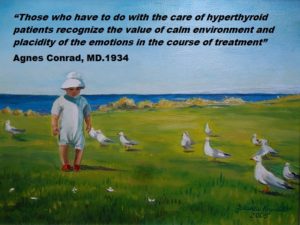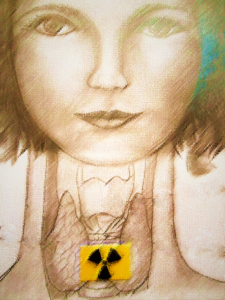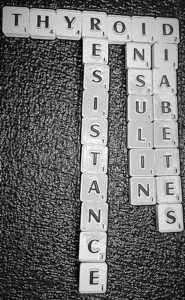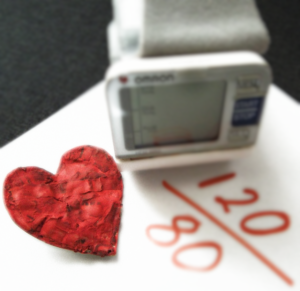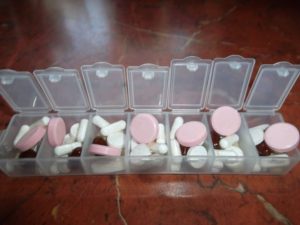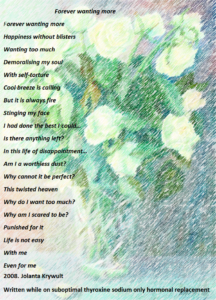All posts by admin
Radioactive Iodine treatment for Graves’ disease – what you should know.
Radioactive Iodine treatment for Graves’ disease – what you should know.
Radioactive Iodine (RAI), I 131 is one of the treatments for Graves’ disease and thyroid cancer. It is a very effective treatment for thyroid cancer but what about Graves’ disease. Is such a drastic treatment justifiable for Graves’ disease?
I am not here to say that the I 131 treatment would not be the right decision for you but the RAI treatment is drastic and non-reversible and so it is important to always make a wise and informed decision that is right for you. In my book, I had listed pros and cons of all treatments for Graves’ disease. RAI treatment works and is generally considered safe by a medical community. At the same time, it is important to talk openly about the possible negatives of RAI treatment.
In his book, ‘Graves’ disease and hyperthyroidism; what you must know before they zap your thyroid with Radioactive Iodine’, Dr. Sarfraz Zaidi (1), stated that many of his patients said they have had never felt the same after RAI.
Dr. Osansky in his book: ‘Natural treatment solutions for Hyperthyroidism and Graves’ disease’ stated that he believes that RAI should be the last resort in the treatment of GD (2).
RAI is the most commonly used treatment for Graves’ disease in USA. It is the cheapest treatment.
What is I 131?
It is a radioactive isotope of iodine introduced in 1940s to treat thyroid problems. It is produced for medical use through nuclear fission in nuclear reactors from neutron-irradiation of a natural tellurium. I-131 is also a by-product of a nuclear fission processes in nuclear reactors and is a significant contributor of radiation after open-atomic bomb testing, Chernobyl disaster and Japanese nuclear crisis. It is a major component of a nuclear fallout. In the case of a nuclear fallout, the dose of radioactivity persists for long periods in a human body due to a sustained and high exposure. RAI treatment for Graves’ disease is short exposure.
What to expect?
The RAI is administered in a separate room in a hospital (nuclear medicine wing). The patient is given a pill or fluid with sodium iodide, which contains radioactive iodine I-131 (the pill will be in a lead encased vial). It has no taste or smell. The patient will be asked to take the pill and swallow it with water or might be asked to drink a fluid containing radioactive iodine from a lead lined jar and needs to stay in the room for around 30 minutes.
The patient will be instructed by the medical staff about the necessary precautions to take in order to avoid contaminating other people with radioactivity. Those precautions must be complied with and are set by Nuclear Regulatory Commission.
What happens inside of the body?
The thyroid gland concentrates the ingested iodine and is unable to distinguish non-radioactive from a radioactive form. After radioactive iodine is swallowed, it goes through the digestive system, is absorbed into the blood stream and is carried to the thyroid gland. As mentioned previously, the thyroid gland concentrates iodine and to the thyroid normal, non- radioactive iodine from food is not distinguishable from radioactive iodine. When the thyroid cells take up radioactive iodine, it emits radiation causing inflammation and necrosis of the cells in the gland. The nucleus of each cell is exposed to the radiation, which breaks its DNA thus destroying the cell. It takes about three months for a dose of radioactive iodine to have its full effect. Eventually the thyroid gland shrinks.
A small amount of radioactive iodine is also taken up by the salivary glands, stomach, small intestine and the breast tissue. The purpose of up taking iodine into these tissues is not known but it is suggested it has to do with iodine antioxidant properties. In the breast tissue, iodine is involved in the regulation of oestrogen receptors.
It is important to note that since the radioactive iodine is taken into other tissues as well, some damage can occur there as well. The radioactive iodine will be secreted through sweat, saliva, urine and other bodily fluids (majority is excreted in about 5 days). The rest of I-131 will be eliminated from the body over the next several weeks in smaller amounts, as the body processes thyroid hormones created with the I-131. It is important to note that these radioactive hormones might be circulating in the blood to all body tissues.
Radioactive iodine is usually used in people over 20 years of age due to possible radiation side effects in children. The general feeling in the scientific community is that RAI should be avoided in children, especially these younger than 5 years of age as it had been noted that small children are more vulnerable to thyroid cancer (as was observed in Chernobyl nuclear disaster and some RAI follow up studies). Thyroid cancer risk may be increased (3, 7). These risks were shown to be increased if RAI was given to people in the first two decades of their life (4).
There are some conflicting studies regarding an increased risk of future cancer after RAI. There might be a minimal increase in developing some forms of cancer in later years (exact risks not established), mainly parathyroid, stomach, bladder, kidney, salivary glands, thyroid and breast. 2007 Finland study showed that the risk of stomach, kidney and breast is increased in people who had RAI (5). A Swedish study (6), which included 10,000 people, showed that the risks were significantly increased for brain, kidney and stomach cancer (risk for stomach cancer increased with a higher dose and longer post treatment time). The study showed “support to the view that a radiation dose delivered gradually over time is less carcinogenic than the same total dose received over a short time.” Another Swedish study (7) showed increased rates for endocrine tumours other than thyroid, lymphomas, leukaemia and nervous system tumours. English and American combined large studies showed small increases in the lung, breast, kidney, and thyroid cancer (3) but the total mortality rate from cancers in RAI treated people was only insignificantly higher and close to the expected norm.
Mortality rates from different causes may be increased with cumulative doses of radioiodine, especially from vascular causes (including heart arrhythmias, cardiovascular and cerebrovascular deaths) and bone fractures after RAI treatment. There are only a few studies done to research the effect of RAI on mortality rates. English study (8) of treated hyperthyroid patients showed marked increases in overall deaths from a year to later life after RAI treatment. This was also found in the Finnish study (9). The results were conflicting with an American study, which did not show increased rates of mortality (10). There have been some stipulation in the medical environment that these increased mortality rates may be due to the original hyperthyroidism, leaving its mark on vascular and overall health. It was concluded that hyperthyroidism was not a reversible disorder without a long-term consequences (14, 15).
Vitamin E, turmeric and Holy basil showed some protection against Iodine 131 damage in salivary glands and the bone marrow in studies in rats (11). Ginkgo biloba may decrease damage to body cells caused by radioiodine therapy in patients with Graves’ disease. A scientific study (12) involving 761 RAI treated patients for GD, showed that ginkgo biloba extract did not change the clinical outcome of RAI therapy. It however could possibly prevent genetic damage effects of radioiodine therapy. Consult your doctor regarding using ginkgo or holy basil.
Personally, I was given a choice of RAI but opted for surgery when I had Graves’ disease. I was planning a family at the time and wanted to get off anti-thyroid medications so I thought that surgery would be the best choice for my unborn children. I was scared of effects of RAI on my body. At the time, I had no idea about holistic approaches to Graves’ disease. To nuke my thyroid or not, that was the question easily answered in my mind as I always associated radioactivity with nuclear testing.
I would be interested in hearing personal stories of people who had RAI. The stories I had read so far, was that some people were happy with their RAI treatment but others regretted having RAI for Graves’ disease.
The blog is for educational purposes only.
References:
- Sarfraz Zaidi, Graves’ disease and hyperthyroidism; What you must know before they zap your thyroid with Radioactive iodine; Comet Press, USA, 2013.
- Eric M. Osansky, D.C. Natural treatment solutions for Hyperthyroidism and Graves’ disease. Natural Endocrine Solutions. 2011. USA.
- Ron E, Doody MM, Becker DV, Brill AB, Curtis RE, Goldman MB, Harris BS 3rd BS, Hoffman DA, McConahey WM, Maxon HR, Preston-Martin S, Warshauer ME, Wong FL, Boice Jr JD. Cancer mortality following treatment for adult hyperthyroidism. Cooperative Thyrotoxicosis Therapy Follow-Up Study Group. JAMA. 1998; 280(4):347–355.
- James A. Lee, Melvin M. Grumbach, and Orlo H. Clark. Controversy in clinical endocrinology. The Optimal Treatment for Pediatric Graves’ Disease Is Surgery. The Journal of Clinical Endocrinology & Metabolism. 2007; 92(3):801–803.
- Saara Metso MD, Anssi Auvinen MD, PhD, Heini Huhtala MSc, Jorma Salmi MD, PhD, Heikki Oksala MD and Pia Jaatinen MD, PhD. Increased cancer incidence after radioiodine treatment for hyperthyroidism. Cancer. 2007 May; 109(10):1972–1979.
- Lars-Erik Holm, Per Hall, Kerstin Wiklund, Göran Lundell, Gertrud Berg, Göran Bjelkengren, Ebbe Cederquist, Ulla-Britt Ericsson, Arne Hallquist, Lars-Gunnar Larsson, Monika Lidberg, Sture Lindberg, Jan Tennvall, Harriet Wicklund and John D. Boice Jr. Cancer Risk After Iodine-131 Therapy for Hyperthyroidism. J Natl Cancer Ins. 1991; 83(15):1072-1077.
- Holm LE, Wiklund KE, Lundell GE, Bergman NA, Bjelkengren G, Ericsson UB, Cederquist ES, Lidberg ME, Lindberg RS, Wicklund HV, et al. Cancer risk in population examined with diagnostic doses of 131I. J. Natl Cancer Inst. 1989 Feb 15; 81(4):302-6.
- Richard B. Singer, MD. Long-Term Comparative Mortality in Hyperthyroid Patients Treated with Radio-Iodine, a Cohort Study in England. J Insur Med 2001; 33:133-137. URL: https://aaimedicine.org/journal-of-insurance-medicine/jim/2001/033-02-0133.pdf
- Saara Metso. Long-term prognosis of patients treated with radioactive iodine for hyperthyroidism.URL: http://tampub.uta.fi/bitstream/handle/10024/67755/978-951-44-7081-3.pdf?sequence=1
- Hoffman DA, McConahey WM, Diamond EL, Kurland LT. Mortality in women treated for hyperthyroidism. Am. J. Epidemiol. 1982 Feb; 115(2):243-54.
- Uma S Bhartiya, Lebana J Joseph, Yogita S Raut, Badanidiyoor S Rao.Vitamin E, turmeric and holy basil has significant radioprotective effects against Radioiodine- 131 exposure in mice. Indian J Exp Biol. 2010 Jun; 48(6):566-71.GreenMedInfo Summary. Jun 01, 2010 URL:http://www.greenmedinfo.com/article/vitamin-e-turmeric-and-holy-basil-has-significant-radioprotective-effects-against.
- Dardano A, Ballardin M, Ferdeghini M, Lazzeri E, Traino C, Caraccio N, Mariani G, Barale R, Monzani F. Anticlastogenic effect of Ginkgo biloba extract in Graves’ disease patients receiving radioiodine therapy. J Clin Endocrinol Metab. 2007 Nov; 92(11):4286-9.
- Dickman PW, Holm LE, Lundell G, Boice JD Jr., Hall P. Thyroid cancer risk after thyroid examination with 131I: a population-based cohort study in Sweden. Int J Cancer 2003 Sep; 106(4):580-7.
- Saara Metso, Anssi Auvinen, Jorma Salmi, Heini Huhtala, Pia Jaatinen. Increased Long-Term Cardiovascular Morbidity Among Patients Treated With Radioactive Iodine for Hyperthyroidism.Clin Endocrinol. 2008;68(3):450-457.URL: http://www.medscape.com/viewarticle/573802_4
- Richard B. Singer, MD. Long-Term Comparative Mortality in Hyperthyroid Patients Treated with Radio-Iodine, a Cohort Study in England. J Insur Med 2001; 33:133-137. URL: https://aaimedicine.org/journal-of-insurance-medicine/jim/2001/033-02-0133.pdf
Naltrexone – a promising medication for autoimmune disorders
Naltrexone – a promising medication for autoimmune disorders
Naltrexone is a medicine used in high doses to treat people with substance addiction problems. Naltrexone binds to opiate receptors.
When a person receives low doses of Naltrexone, it works only for a short time but manages to send signals to the body to increase the production of endorphins which assist in balancing of the immune system. Naltrexone is believed to have little side effects on the body in low doses taken at bedtime and it may help with metabolic processes. There are some positive reports from people with thyroid autoimmunity on internet forums. Many report a reduction in thyroid antibodies.
There has been some small pilot studies on use of Naltrexone for other autoimmune disorders (doses around 1.5 to 4.5mg/daily), such as Crohn’s disease, MS and fibromyalgia with positive outcomes. There are also reports of positive benefits in other autoimmune disorders and illnesses by pioneering physicians, such as Dr. Bihari. However there are no scientific studies on Naltrexone and Graves’ disease or Hashimoto’s thyroiditis at the moment. Even though it has not been approved for treatment of Graves’ disease, some doctors prescribe it.
Naltrexone can increase the levels of endorphins in the brain. The levels of endorphins are lowered in Graves’ disease, also due to chemical imbalances in the brain and lowered levels of GABA, a calming chemical.
So, why endorphins are so important? Endorphins are ‘feel good’ chemicals produced by the body like natural opiates, similar to morphine. They are a reward system for our body cells, which enhance our life experience. Endorphins are produced in the brain when we experience happiness, love and relaxation. They are reduced on exposure to chronic stress and pain, with levels varied among individuals. The levels of these ‘happy molecules’ may be reduced in people with autoimmunity. We can see that when describing what endorphins do in the body. They strengthen and balance the immune system, reduce blood pressure, heart rate, dilate blood vessels, slow down breathing, reduce stress, lower pain, slow down neuron firing, improve digestion, excretions of harmful toxins and give feelings of pleasure, love and reward.
To enhance levels of endorphins in the brain, smelling scents and oils, such as lavender, chamomile, rosemary, mint, vanilla and grapefruit may help. Rhodiola rosea herb may also help to increase endorphins. Nutritional yeast (or brewer’s yeast) is high in inositol, which may help to enhance endorphins. Flaxseed oil and fish oil enhance the release of endorphins. Cacao and chocolate stimulate the secretion of endorphins. Craving for chocolate and fatty foods might indicate low level of endorphins in a person. Other pleasurable activities, such as listening to slow rhythmic music, looking at beautiful pictures, smiling, loving, exercise, massage and laughter may all increase endorphins levels. Living peaceful life with positive attitude and expression of one’s feelings would enhance endorphins. Being in a secure, loving and stable relationship is also beneficial. Even acupuncture, reasonable sun exposure and spending time in nature increase endorphins levels. Meditation is also beneficial as alpha rhythms (electrical patterns or waves in brain), which increase during meditation, tend to stimulate the release of endorphins. Lack of vitamins C and B and other minerals reduces endorphins.
References:
- Medical Hypotheses 72 (2009) 333–337 URL: http://www.opioids.com/naltrexone/lowdosenaltrexone.pdf
- The Use of LDN for MS, Crohn’s, and Other Autoimmune Diseases by Elaine Moore. URL: http://www.elaine-moore.com/Articles/LowDoseNaltrexone/LDNUseforMSCrohnsandOtherAIDiseases/tabid/195/Default.aspx
- Thyroid. Factor Fiction. URL: http://www.tiredthyroid.com/blog/2012/02/20/ldn-low-dose-naltrexone-for-graves-and-other-autoimmune-diseases/
- The low dose Naltrexone Homepage. URL: http://www.lowdosenaltrexone.org/
- LDN and Autoimmune Disease. URL: http://www.lowdosenaltrexone.org/ldn_and_ai.htm
- LDN science. URL: https://www.ldnscience.org/ldn/how-does-ldn-work
Thyroid hormonal imbalance and blood sugar problems
Thyroid Hormone Imbalances and blood sugar problems
Thyroid hormones imbalances, both hyper and hypothyroidism can cause poor blood sugar control, increase the risk of insulin resistance and the risk of developing type 2 diabetes due to effects of thyroid hormones on the production, demand and performance of insulin in the body and common genetic factors. There is plenty of scientific evidence supporting the contribution of thyroid hormonal imbalances to Type 2 Diabetes Mellitus. All hormonal system are intertwined. Autoimmune thyroid conditions also increase the risk of Type 1 Diabetes Mellitus ( autoimmune illness) and vice versa.
Blood sugar needs to be kept at between 3.9 and 5.5 mmol/L (70 to 100 mg/dL). It is regulated by few factors: glucose storage and release from glycogen by the liver, intestinal absorption, glucose uptake in muscles and fat cells and the production of insulin by pancreas. Insulin is a hormone made in pancreas which takes the sugar out of blood when it gets too high.
Thyroid hormone imbalances change expression of certain genes and production of proteins which can affect insulin sensitivity of cells. They also cause changes in plasma fatty acids which also modulate insulin sensitivity.
Insulin resistance happens when the insulin receptors in body cells do not respond properly to insulin and so the sugar from blood cannot be taken inside of cells to produce energy. Insulin resistance can progress and lead to Type 2 Diabetes Mellitus, a conditions where pancreas can no longer produce enough insulin to overcome insulin resistance.
Thyroid hormone is the hormone that starts the energy production inside of the cells and insulin helps to supply the cells with fuel-glucose. The hormonal systems work together so it is clear that imbalance of one will imbalance the other.
Hyperthyroidism
The increase in thyroid hormones signals the body to rapidly increase energy production and stimulates liver through the sympathetic nervous system. That is the main reason for glucose intolerance. The needs for glucose increase to keep up with an increased metabolic rate. Growth hormone somatotropin is released accelerating the production of liver glycogen to glucose. There is also a rapid glucose absorption from the intestine. In Graves’ disease, more proinsulin is secreted from the pancreas. It is however not properly converted to insulin. Insulin is also more rapidly degraded in kidneys. Hyperthyroidism is associated with insulin resistance of liver cells. The liver cells overproduce glucose and are ‘deaf’ to insulin signals. However, the skeletal muscle cells have an increased glucose absorption. The production of energy from glucose is changed towards glycolysis and lactate formation in muscles. It has been shown in Japanese studies that people with Graves’ disease are twice as much of a risk of developing non insulin-dependent diabetes (type II) diabetes when compared to a healthy population (1).
A medication, called thiazolidinedine, used sometimes to increase insulin sensitivity should not be given to people with type 2 diabetes, thyroid autoimmunity and ophthalmopathy as it may worsen the eye condition (7). Also when people with thyrotoxicosis (excessive thyroid hormones) and diabetes are given too much insulin, they at risk of diabetic ketoacidosis, which increases the risk of a cardiac arrest, therefore these two conditions of hyperthyroidism and diabetes need to be controlled properly.
Unfortunately, there is also an increased chance of developing Type 1 Diabetes, which is Insulin Dependent Diabetes Mellitus, an autoimmune condition. People with thyroid dysfunction (not related to autoimmunity) do not have an increased chance of developing Type 1 Diabetes Mellitus which is an autoimmune illness. Type 1 Diabetes Mellitus can co-occur with Graves’ disease as both are autoimmune conditions and they have common genetic components. This is often seen in younger people with Graves’ disease. The chance of having another autoimmune illness with Graves’ disease is about 9-10% and slightly higher for Hashimoto’s thyroiditis (19).
Hypothyroidism
T3 is an extremely potent elixir of life. Hypothyroidism and insulin resistance go together. Lack of T3 (even sub-clinical) may lead to blood sugar problems, insulin resistance and type 2 diabetes. The risk of developing type 2 diabetic is higher in hypothyroidism than hyperthyroidism. Low T3 causes liver and pancreatic function to be poor, lowers the secretion of insulin and stresses those organs. Low T3 also causes impaired glucose metabolism in peripheral tissues. The peripheral muscles become less responsive to insulin. The transport of glucose inside of cells is impaired due to lowered expression of transport genes due to hypothyroidism. Also there is reduced disposal of glucose. Under methylation issues has been postulated as a possible mechanisms, which increase insulin resistance. Another one is the dysregulation of metabolism of leptin, hormone which regulates hunger. Hypothyroid people store less glucose in the liver as glycogen and are more prone to low blood sugar. As a consequence, both adrenaline and cortisol start rising at night. Adrenaline can peak around 2am and a person can wake up with heart palpitations. Cortisol hormone may be high in early morning, raising fasting blood sugar. I certainly had that happen to me when I was hypothyroid as mentioned in my previous post. I used to get up and have a snack in the middle of the night, which always stopped the heart palpitations.
Thyroid is a major player in the part of brain called hippocampus which is very vulnerable brain region in general as it modulates glucose metabolism and insulin signalling. Damage to hippocampus has been connected to hypothyroidism, memory problems, special navigation problems, dementia and Alzheimer’s disease. It may also be connected to the development of type 2 diabetes.
Metformin is sometimes given to people with insulin resistance to improve their insulin sensitivity, however optimal thyroid hormonal replacement may also be effective in increasing insulin sensitivity in some cases. Metformin may deplete vitamin B12 so it is important to watch your levels. It was noted that the levels of TSH decrease with metformin in people on levothyroxine hormonal treatment which indicates that there is an improvement in hypothyroid state (10, 11) without a change in FT4 levels, thyroid hormones seem to work better with improved insulin sensitivity. This is not surprising as too much insulin is antagonistic to thyroid hormones and blocks thyroid hormonal receptors.
In my personal case, I had blood sugar issues when I was on levothyroxine only hormonal replacement and also when I suffered from thyrotoxicosis. My glucose tolerance test was impaired.
Natural desiccated thyroid and levothyroxine combination had normalised my blood sugar. Natural bio-identical progesterone hormone which I was taking while on levothyroxine only hormonal replacement also helped in improving my blood sugar. Progesterone enhanced my T4 into T3 conversion all by itself and improved my hypothyroid symptoms.
Obviously type 1 diabetics need insulin hormone for survival as the pancreatic beta cells producing insulin are destroyed by an autoimmune reaction.
Ways which may improve insulin sensitivity and lower blood sugar:
Vitamin D helps thyroid autoimmunity and insulin resistance and increases insulin secretion from pancreas (16).
Optimal thyroid hormonal levels, proper control of hyperthyroidism and hypothyroidism is important.
Optimal hormonal replacement for hypothyroidism, consider NDT or levothyroxine/NDT combination to improve blood sugar control
Balancing other hormones
Other:
Vitamin B1 especially (Benfotiamine, fat soluble form of B1 might be beneficial)
Chromium mineral, vanadium, and B vitamins (Brewer’s yeast can provide these)
Magnesium
Vitamin C, clinical study shows that vitamin C can lower blood sugar (9)
Changes to nutrition (sugar limiting, healthy vegetable rich diet, more fibre, less saturated fat and more essential fatty acids (fish oil, flaxseed, and olive oil), not combining protein and sugar in a meal)
Essential fatty acids, coenzyme Q10, alpha lipoic acid, zinc
Exercise (short bursts of intense exercise were shown to reduce insulin resistance)
Limiting stress as cortisol produced during stress, increases blood sugar
Apple cider vinegar
Herbs which may help:
Gymnema sylvestre (good formula is GlucoBalance by Mediherb which also contains vitamins and minerals), small human study (18) showed positive blood sugar lowering effects.
Others: Bitter melon (also available in capsules), garlic, onion, prickly pear, soursop, chaste berry, Rhodiola rosea, guava leaves, fenugreek used in cooking and cinnamon
This post is for educational purposes only. Any supplements to lower blood sugar should be taken under doctor’s supervision.
References:
-
-
-
- Komiya I, Takasu N, Yamada T, Ohara N, Ootsuka H, Ota M, Fukushima H, Sekikawa A, Tominaga M, Sasaki H. Studies on the association of NIDDM in Japanese patients with hyperthyroid Graves’ disease. Horm Res. 1992; 38(5-6):264-8.
- Lombadiari V, Mitrou P, Maratou E, Raptis AE, Tountas N, Raptis SA, Dimitriadis G. Thyroid hormones are positively associated with insulin resistance early in the development of type 2 diabetes. Endocrine. 2011 Feb; 39(1):28-32.
- Brenta G. Why Can Insulin Resistance Be a Natural Consequence of Thyroid Dysfunction? Journal of Thyroid Research 2011. URL https://www.hindawi.com/journals/jtr/2011/152850/
- Thyroid Autoimmunity in the Context of Type 2 Diabetes Mellitus: Implications for Vitamin D
- Valerie Witting, Dominik Bergis, Dilek Sadet and Klaus Badenhoop. Thyroid disease in insulin-treated patients with type 2 diabetes: a retrospective study. Thyroid Res. 2014; 7: 2.
- Chaoxun Wang .The Relationship between Type 2 Diabetes Mellitus and Related Thyroid Diseases. Journal of Diabetes Research. Volume 2013. URL: https://www.hindawi.com/journals/jdr/2013/390534/ref/
- Menaka R, et Thiazolidinedione precipitated thyroid associated ophthalmopathy. J Assoc Physicians India. 2010 Apr; 58:255-7.
- Yeo KF, et. Simultaneous presentation of thyrotoxicosis and diabetic ketoacidosis resulted in sudden cardiac arrest. Endocr J. 2007 Dec; 54(6):991-3.
- Dice, J. F. and Daniel, C. W. (1973).The hypoglycemic effect of ascorbic acid in a juvenile-onset diabetic. International Research Communications System, 1:41. URL: https://www.seanet.com/~alexs/ascorbate/197x/dice-jf-ircs-1973-march-p41.htm
- Theodora Pappaa and Maria Alevizakia,b. Metformin and Thyroid: An Update. Eur Thyroid J. 2013 Mar; 2(1): 22–28.
- Cappelli C, Rotondi M, Pirola I, Agosti B, Gandossi E, Valentini U, De Martino E, Cimino A, Chiovato L, Agabiti-Rosei E, Castellano M (2009) TSH-lowering effect of metformin in type 2 diabetic patients: differences between euthyroid, untreated hypothyroid, and euthyroid on L-T4 therapy patients. Diabetes Care 32(9):1589–1590.
- Abdullah Zeid Badbayyan, Yaman Mazen Almerstani, Mohamed Osama Allulu, Awni Mazen Al-lolo, Ghaliah Abdullah Al-haqas, Abdulrahman Ahmed Alnaser. Association between thyroid hormones. Changes and development of Type 2 Diabetes: (Systemic review). International Journal of Healthcare Sciences. 2016 (4):2:966-971.
- Coller FA, Huggins CB. Effect of hyperthyroidism upon diabetes mellitus: striking improvement in diabetes mellitus from thyroidectomy. Annals of Surgery. 1927; 86(6):877–884.
- Lambadiari V, Mitrou P, Maratou E, et al. Thyroid hormones are positively associated with insulin resistance early in the development of type 2 diabetes. Endocrine. 2011; 39(1):28–32.
- Kapadia KB, Bhatt PA, Shah JS. Association between altered thyroid state and insulin resistance. Journal of Pharmacology and Pharmacotherapeutics. 2012; 3:156–160.
- Talaei A, Mohamadi M, Adgi Z. The effect of vitamin D on insulin resistance in patients with type 2 diabetes. Diabetol Metab Syndr. 2013; 5:8.
- Beltramo E, Berrone E, Tarallo S, Porta M. Effects of thiamine and benfotiamine on intracellular glucose metabolism and relevance in the prevention of diabetic complications. Acta Diabetol. 2008 Sep; 45(3):131-41.
- Diabetes in control. URL: http://www.diabetesincontrol.com/effect-of-extended-release-gymnema-sylvestre-leaf-extract-beta-fast-gxr/
- Boelaert K, Newby PR, Simmonds MJ, Holder RL, Carr-Smith JD, Heward JM, Manji N, Allahabadia A, Armitage M, Chatterjee KV, Lazarus JH, Pearce SH, Vaidya B, Gough SC, Franklyn JA. Prevalence and relative risk of other autoimmune diseases in subjects with autoimmune thyroid disease. Am J Med. 2010 Feb; 123(2):183.e1-9
-
-
Thyroid problems and blood pressure connection
Thyroid problems and blood pressure connection
Blood pressure can be affected by many factors. Thyroid hormone imbalances affect blood pressure greatly. In my previous post, I had talked about body temperature being indicative of thyroid dysfunction. Blood pressure is also a strong indicator of thyroid function for people with thyroid hormonal imbalances. It is important to observe body signals as they are number one indicators that something is not right with thyroid hormones for people with thyroid issues.
I remember one day driving to my doctor for a check- up visit in heavy traffic while munching on chocolate coated coffee beans. I was almost late and when I saw my doctor, I was a bit flustered. I had a busy, stressful day. During a consultation with my doctor, she measured my blood pressure and it was through the roof. I do not know about you but I always get a bit nervous when my doctor is about to measure my blood pressure despite trying to stay calm and breathing deeply. Just feeling stressed, uncomfortable can raise blood pressure by itself. Blood pressure often fluctuates throughout the day. However it is not the temporary spikes of blood pressure we have to worry about but the sustained, chronic high blood pressure. Some people are not aware of their raised blood pressure. Blood pressure problems may be silent. For me, headaches, general tension, pins and needles in my arms and whooshing sound in my ears in the evening points to a possible blood pressure problem and possible hormonal imbalance. During my consultation that day, I had found out that my TSH value was 0.22, too low for me. I operate best at value of 1.7 so the dose of my hormonal replacement was slightly reduced and blood pressure came down. I also stopped drinking coffee and went to have decaffeinated variety and no more chocolate coated coffee beans!
I will explain how thyroid hormones affect blood pressure. When your doctor measures your blood pressure with a blood pressure monitor (sphygmomanometer), she or he inflates a cuff on your arm to collapse and then release the brachial artery under the cuff. A doctor usually uses a manual sphygmomanometer and listens to your brachial artery through a stethoscope. However there are digital blood pressure monitors available as well. When the pressure is released slowly from the cuff, the doctor listens to a first whooshing sound in your artery. This sound represents your systolic reading, it is when the blood starts flowing again in the artery, forced through by a heartbeat. Then as the cuff falls farther, the sound stops and the reading of diastolic blood pressure is taken at that moment. That reading represents the blood pressure in your artery between the heart beats, at the resting phase of the cardiac cycle. Therefore, blood pressure represents the force of blood against the arterial wall. The systolic pressure shows the power of the heart contraction and the force of blood being pumped in the artery. The second diastolic pressure represents the dilation and flexibility of the arteries.
Normal blood pressure is around 120 (systolic) and 80 (diastolic), 120/80.
High blood pressure is 140/90 or above.
The operating centre for blood pressure is present in the brain stem where signals from the body are processed. Blood pressure system is regulated by renin- angiotensin- aldosterone system and by sympathetic nerves and hormones adrenaline and noradrenaline.
While, there are many factors which can influence blood pressure, I will concentrate on thyroid dysfunction specifically in this post. Both the sympathetic and hormonal systems are deregulated in thyroid dysfunction. It has been suggested in scientific literature that there is a disconnection in the renin-angiotensin-aldosterone system in both hyperthyroidism and hypothyroidism as the functioning of kidneys is affected. Thyroid and renal function are interrelated.
Hyperthyroidism
People with Graves; disease have an increased rate and depth of respiration as well as higher blood pressure and a rapid heartbeat. There may be over 100 heart beats per minute. The systolic blood pressure is usually considerably higher than 120 and more raised than diastolic. Normal blood pressure is around 120 (systolic) and 80 (diastolic). In hyperthyroidism the reading for blood pressure is generally (≥140/<90 mm Hg). It is called systolic hypertension. It is also called secondary hypertension as thyroid hormones are the underlying cause of the high blood pressure. The pulse pressure is the difference between the systolic and diastolic pressure. The normal resting pulse pressure is therefore around 30-40 mmHg. People with GD have widen resting pulse pressure.
Too much thyroid hormones in blood increases metabolic rate. The heart and cardiovascular need to adjust. The excess of thyroid hormones increases the use of oxygen in the body. The sympathetic nervous system (SNS) is dominant in Graves’ disease, activated by excessive thyroid hormones. It is a system which is normally responsible for a ‘fight of flight’ body response to a dangerous and stressful situation and it releases catecholamines- epinephrine and norepinephrine from adrenal glands to accelerate the heart rate and increase blood pressure. The effects of hyperthyroidism include increased cardiac output, contractility, tachycardia, widened pulse pressure and dilation of peripheral blood vessels. Heart often goes into a ‘marathon run’. Heart related problems, such as palpitations (strong and fast beating of the heart) is a common symptom of Graves’ disease. This can also cause irregular heartbeat sometimes. Atrial fibrillation (type of a heart arrhythmia) can be seen.
Thyroid hormones increase other hormones such as aldosterone (from adrenals) and renin (from kidneys) secretion. This also increases blood volume and blood pressure by causing water to be reabsorbed along with sodium while more potassium is excreted in urine. Thyroid hormones and kidneys stimulate the development of red blood cells which also increases blood volume. Kidneys increase in mass with hyperthyroidism. Long term hypertension may lead to heart disease as it strains the heart.
Hypothyroidism
Generally, hypothyroidism can in time significantly increase diastolic pressure, raising it above 90 mm Hg. It is often called hypothyroid hypertension. This is due to the fact that over time, continuous hypothyroidism causes changes to blood vessels, they become ‘stiff’ and constricted. The systolic blood pressure reading may also become elevated. However, there is a narrow pulse pressure.
Hypothyroidism is very stressful for the body. The body has to increase blood pressure to fight the slow metabolic rate and consequences of negative effects of low thyroid levels. It tries to do it with other hormones and molecules. The sympathetic and adrenal system is activated. The levels of adrenal norepinephrine were found to be elevated in hypothyroidism. Adrenal aldosterone hormone imbalance is connected to hypothyroidism and its increased levels may result in a constriction of blood vessels and elevated diastolic (bottom number) blood pressure. Cortisol hormone levels spike at times, especially in the morning in order to raise blood pressure and to increase the heart rate. Aldosterone hormone can spike about 2am. I had found myself awake at 2am with heart palpitation when I was on a levothyroxine hormonal replacement only. I discovered that if I had something to eat in the middle of the night, my palpitations would stop. Aldosterone hormone increases blood pressure to deliver more glucose to body tissues when levels get too low due to hypothyroidism. At the same time the kidneys function is slower and they can get smaller in size. It was found that plasma renin (produced in kidneys) and angiotensin levels were lowered with hypothyroidism. Water clearance is reduced. Hypothyroidism is a low-renin hypertensive state, which means that levels of sodium in body decrease causing fluid retention. Low thyroid hormonal levels result in the inflammation and plasticity loss of blood vessels. Arterial stiffness is an important determinant of arteriosclerosis, which increases the risk for heart attack and strokes. Thyroid hormones promote the synthesis and action of vasodilators which acts directly on muscles in our arteries. However with low levels, the vessels become less flexible. The synthesis of nitric oxide (a powerful chemical, which dilates blood vessels) from L-arginine is stimulated by T3. Imagine your heart trying to pump blood through blood vessels in the body, which cannot effectively dilate and a resulting stress and damage to the cardiovascular system.
My own experience
The levothyroxine hormonal replacement after my thyroid surgery has raised my T4 levels high over time (in the top of the T4 reference range) while my T3 hormonal levels were low borderline. I suffered from T4 thyrotoxicosis and T3 deficiency. I had developed severe high blood pressure, felt stressed, had needle and pins in my arms and suffered from severe migraines. I went to see a doctor who prescribed a beta blocker -propranolol for my blood pressure problems. I started taking the medication but after few weeks I developed severe muscle spasms, horrible pains in my jaw and terrible muscular pain coupled with some degree of depression. I went to a doctor again and I got prescribed strong antibiotics because he believed my inability to open my mouth and the pain in my jaw and ears indicated some severe throat infection. I came home, while drinking water through a straw and shaking, I had a light bulb moment and realized that propranolol stopped the conversion of T4 (levothyroxine) to T3 (active hormone) in my body. The blood pressure medication had severely depleted my T3 levels which were low to start with. I did not have throat infection or some other terrible illness, I had a severe T3 deficiency. The balance between T4 and T3 is vital. It seemed that in my case, the high T4/low T3 levels caused my high blood pressure. Both, my systolic and diastolic readings were increased but my diastolic blood pressure was significantly raised.
My experience has lead me on a journey of discovery. I had learned that balancing my hormones is important for lowering my blood pressure. I added Natural Desiccated Thyroid (NDT) to my levothyroxine treatment, which ended my blood pressure problems at the time.
Since then, I had invested in blood pressure monitor and check my blood pressure occasionally. It is important to make sure the thyroid hormonal replacement is optimal as any imbalance will eventually show in blood pressure changes. Also, levothyroxine only treatment created a state of oestrogen dominance in my body, which farther decreased T4 into T3 conversion. Natural progesterone cream also helped to get my blood pressure to completely normal levels. More on that in later posts.
References:
- Danzi S, Klein I. Thyroid hormone and blood pressure regulation. Curr Hypertens Rep. 2003 Dec; 5(6):513-20.
- Fommei E, Iervasi G. The role of thyroid hormone in blood pressure homeostasis: evidence from short-term hypothyroidism in humans. J Clin Endocrinol Metab. 2002 May; 87(5):1996-2000.
- Marcisz C, Kucharz EJ, Marcisz-Orzel M, Poręba R, Orzel A, Sioma-Markowska U. Changes of poststimulatory plasma renin activity in women with hyperthyroidism or hypothyroidism in relation to therapy. Neuro Endocrinol Lett. 2011; 32(3):301-7.
- Julia H. Hauger-Klevene, Harold Brown, Jose Zavaleta. Plasma Renin Activity in Hyper- and Hypothyroidism: Effect of Adrenergic Blocking Agents. J Clin Endocrinol Metab (1972) 34 (4): 625-629.
- Ogihara T, Yamamoto T, Miyai K, Kumahara Y. Plasma renin activity and aldosterone concentration of patients with hyperthyroidism and hypothyroidism. Endocrinol Jpn. 1973 Oct; 20(5):433-7.
- Hypothyroidism and Hypertension. Stella Stabouli; Sofia Papakatsika; Vasilios Kotsis URL: http://www.medscape.com/viewarticle/733788_3
How to recognize outward body signs of hypothyroidism
How to recognize outward body signs of hypothyroidism
Outward body signs are not used for a definite diagnosis of a health condition but they can tell us a lot about the state of our body. A sign of an illness is always there somewhere on the outside.
Hypothyroid people experience many negative health issues such as tiredness, overall weight gain, muscle and joint pain, headaches and varied levels of depression. However the outward appearance is also a good indication of a low thyroid hormonal state or problems with the functioning of thyroid hormones.
Changes or abnormalities in eyes, skin, hair and nails and general appearance of a person can be signs of hypothyroidism and the degree of changes also relates to the severity of the illness.
The outward signs of hypothyroidism are connected to a changed functioning of many organs and nutritional deficiencies as thyroid hormones deficits affect every cell in the body. Thyroid hormone directs metabolism and production of proteins (such as keratin in your skin, nails and hair).
I will therefore also explain the outward changes in relation to nutritional deficiencies, stress and other organ functions which can be affected by a low thyroid function.
Some health practitioners read eyes, their iris and white area. I will not go into eye diagnosis as iridology and sclerology knowledge is a complex science of its own. A health practitioner had once read my irises and at the time, diagnosed me with severe magnesium deficiency and tight muscles. Her reading was accurate.
Let’s start on what you can see with hypothyroidism. Of course, the outward signs may be individual and not all are experienced by everybody. The appearance changes can be very mild or more dramatic.
Hair– losing about a small ball of hair every day, hair is thinned out especially in the front. It appears lifeless, without a shine, can be normal or coarse and brittle.
Why?
Loss- Low thyroid, other hormonal deficits, possible deficiencies of vitamin B2, B3, B5, B6, B7, B12, inositol, D, A, C, sulphur, biotin, zinc, iodine, selenium, calcium, magnesium, low iron stores, taurine, essential fatty acids, bile insufficiency, adrenal insufficiency, autoimmunity problems (Alopecia- more patchy and severe hair loss when compared with hypothyroidism)
Thin, lifeless- low thyroid, iron and biotin (B7) deficiency
Brittle- sulphur deficiency
Face– puffy looking (varying degrees), pale, lifeless, swelling under eyes especially in the morning, ‘bags under eyes’, double chin, swelling in the upper cheeks, looking older and more tired.
Why?
Low thyroid, lowered kidney glomerular filtration rates, accumulation of toxins, deficiencies in nutrients
Eyes– look tired, kind of lifeless without a spark, may be dry, rarely may have an uneven appearance, some people may have some puffiness on the eyelids, dark circles under eyes, redness around the eyes, poor night vision and pale inner lower eye lids skin
Why?
Apart from hypothyroidism contributing factors are:
Dark circles under eyes- food intolerance, allergies, adrenal weakness, iron deficiency, lack of sleep, stress. Some of the causes of iron deficiency can be copper deficiency (makes iron unavailable), stress, autoimmunity and heavy menstrual bleeding.
Bags under eyes- allergies, food intolerance, toxin accumulation in the body, low iodine.
Dry – Vitamin A and/or vitamin D deficiency
Redness or cracking at the outer angle of the eyes- Vitamins B2 or B6 deficiencies
Pale inner lower eye lids skin- anemia (iron deficiency)
Poor night vision –vitamin A deficiency
Eyebrows- may be thinning with 1/3 of outer eyebrows lost
Beard- thinning
Why?
As for hair
Lips– may crack, peel, feel dry and look pale
Why?
Apart from a low thyroid, low iron and B12 vitamin (common with hypothyroidism), vitamin B2 deficiency, thrush, sugar balance problems (also connected to hypothyroidism)
Bleeding gums
Why?
Low thyroid, vitamin C deficiency
Mouth– may feel dry
Why?
Low thyroid, possible iron deficiency, vitamin B2 deficiency, sugar balance problems and dehydration.
Tongue– swollen with lateral teeth indentations (scalloped tongue), may have some white coating on it.
Why?
Hypothyroidism, inflammation, poor fluid flow and stagnation, vitamin B2 deficiency, allergies, not enough nutrients in the body, low protein, poor stomach acid, unhealthy gut, stress, anxiety, some other diseases or conditions and dehydration.
Light white coating – poor circulation in extremities, poor stomach acid and indigestion.
Neck– goitre possible
Why?
Iodine deficiency, selenium deficiency, autoimmunity
Hands– may be swollen (it is hard to take a ring off), cold and dry, swelling of fingers is related to low vitamin B6 and swelling generally related to a reduced kidney filtration rates and accumulation of toxins. Carpal tunnel syndrome may be a problem with hypothyroidism (also connected to vitamin b6 deficiency).
Heals
Cracked and rough
Why?
Low thyroid
Nails– thin, brittle, have pits and grooves, splitting, grow more slowly and may have some deformities, they usually have longitudinal (vertical) ridges, cuticles can be jagged with rough edges, lack of lunula (the white half-moons) on most fingers (connected to slow metabolism, also connected with low iodine and anemia- iron or vitamin B12 deficiency). Healthy people should have white, good lunulas.
It is traditionally believed that pronounced vertical ridge formation on the nails relates to a low thyroid, a possible weakness in the digestive tract that results in compromised assimilation of nutrients (leaky gut, food sensitivities, poor digestion), common with increasing age (most likely due to a poorer digestion), may also relate to selenium deficiency, often a zinc and vitamin B deficiencies.
Apart from hypothyroidism, other related deficiencies may be present that change the appearance of the nails.
Rough cuticles – biotin, zinc deficiency
Brittle nails that split easily may also indicate a fatty acid, protein, vitamin A deficiency, iron or calcium deficiency and a low stomach acid.
Soft/brittle nails: may be a magnesium deficiency or iron deficiency
Brittle nails generally- apart from hypothyroidism, fatty acid deficiency, biotin, vitamin A, iron, sulphur, magnesium or calcium deficiencies
Nails with white flecks or lines may result due to a zinc or vitamin B6 deficiency.
Excessively dry nails may be due to a Vitamin B12 deficiency
Slow growing, dry nails- may be indicative of a vitamin A or iron deficiency
Beads that appear to drip down the nail like wax -vitamin B deficiencies
Brown-grey fingernail and toenail discoloration- possible vitamin B12 deficiency
Small depressions (grooves) in a nail- iron deficiency
Curved upwards- severe iron deficiency
Skin– dry, pale, thick, cold, puffy face, can have rough scales and yellowish appearance (especially on the palms and soles), swelling may be present in extremities (hand, fingers, swollen ankles, feet and face), skin may bruise easily, be itchy, sweat less and wrinkle. Some people notice an increase in acne or dry lichen like patches on their skin.
Why?
Hypothyroidism causes dryness by decreasing the function of sebaceous and sweat glands. Pallor is related to a decreased skin blood flow and anemia (iron and vitamin B12 deficiency are common). Pink urine after eating beetroots may be an indication of low iron. Yellow skin tint is connected to the deposition of carotene as the conversion of carotene to vitamin A is slow with hypothyroidism. Dry, scaly and flaking skin – apart from low thyroid, contributing factors are low vitamin A, D, fatty acids, zinc, potassium and dehydration. Swollen ankles may also relate to a low vitamin B1 caused by malabsorption due to hypothyroidism. Tingling, Prickling, and Numbness in in hands and feet can also relate to B-vitamin deficiency (particularly folate, B6, B5 and B12) and minerals such as calcium and phosphorous. Bruising- low thyroid, low vitamin C and other problems.
Muscles
Tender calf muscles – magnesium deficiency
General appearance: tired and bloated
Why?
Low thyroid causes fluid retention and poor sleeping.
General recommendations to consider with hypothyroidism:
Make sure your thyroid function and thyroid hormonal replacement are optimal.
Consider adding Natural Desiccated Thyroid to levothyroxine hormonal replacement
Check your nutritional profile (vitamin B12, iodine, zinc selenium, magnesium, calcium and iron)
Improve stomach acid with apple cider vinegar (in some water before the main meal) and Betaine –HCl (only for those diagnosed with a low stomach acid)
Consider adding vitamins B to your diet (I personally use Brewer’s yeast)
Consider adding plenty of natural vitamin C (I personally use Acerola cherry powder)
Good adrenal support herbs (such as those containing Rhodiola rosea)
Reduce stress
Rest adequately
Optimize your nutrition (lots of green leafy greens, healthy varied diet with essential fatty acids)
Please note this blog is for educational purposes only. Please contact your doctor if you are worried about any outward changes in your appearance. Changes in skin, hair, nails and eyes may be connected to other illnesses apart from hypothyroidism.
I welcome any comments and personal stories you might want to share to help others.


